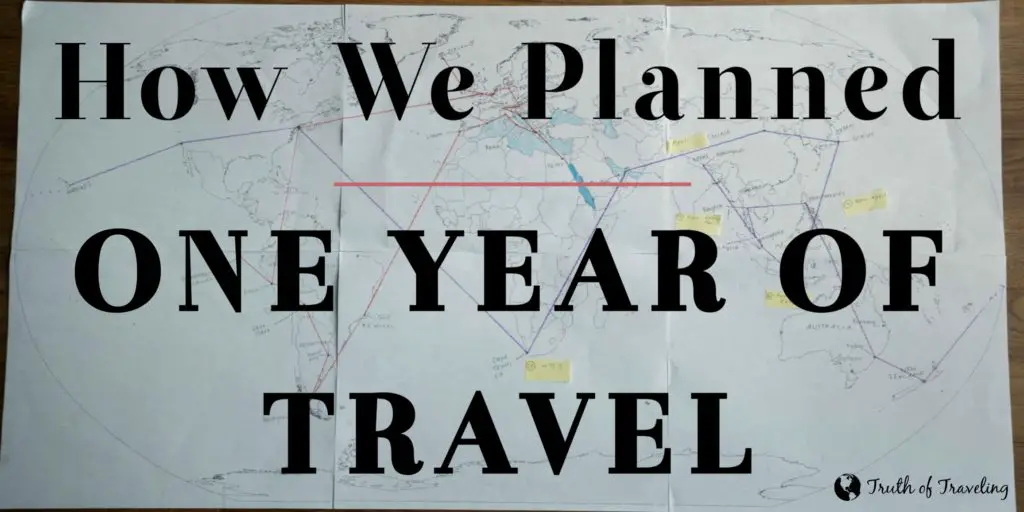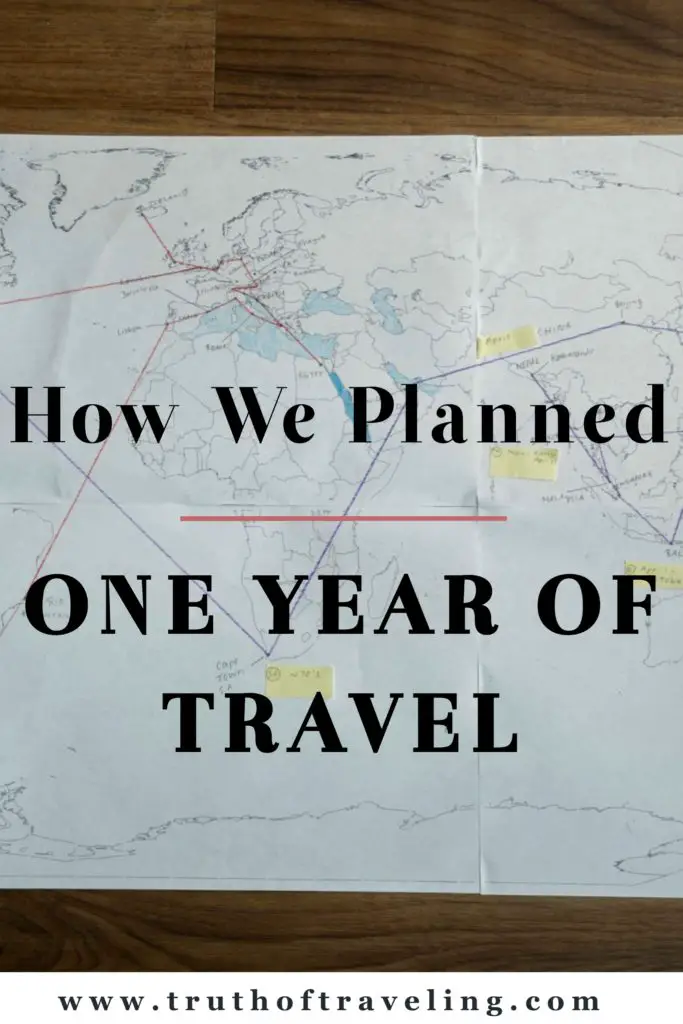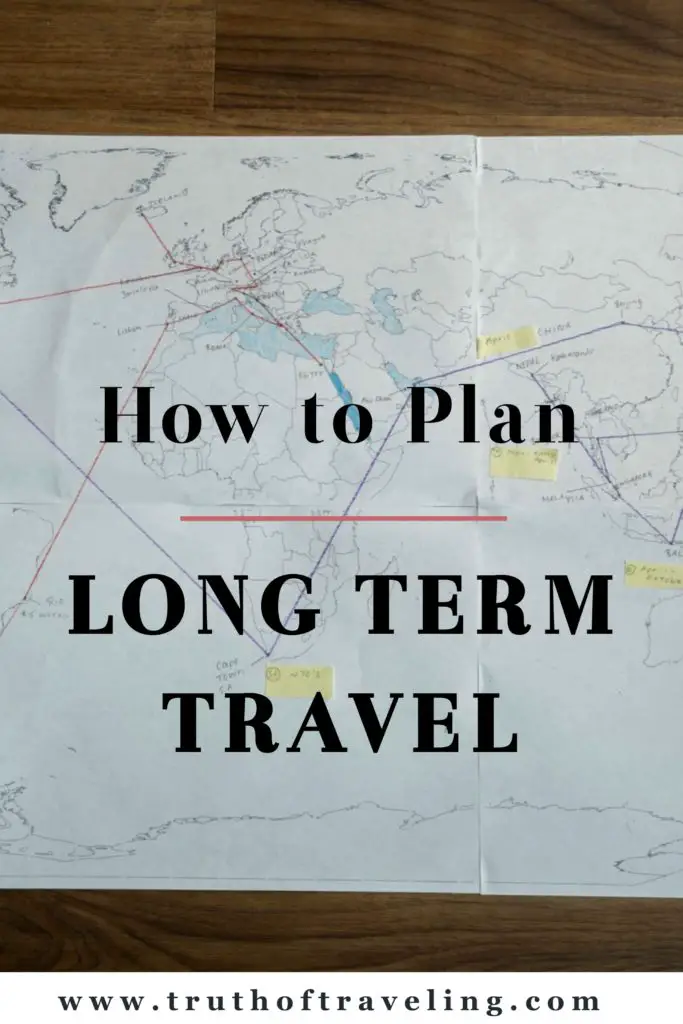Planning a year’s worth of travel can be a huge task depending on the type of traveler that you are. Some people may just go with the flow and figure it out along the way and others will try to cram as much as possible into a tight schedule. We fall somewhere in the middle of those two methods. The difficulties pop up when you take into account visa limits, rainy vs. dry seasons, and specific things we want to do in certain places. In this post we explain how we planned a year of travel and all the things we thought about in order to make the rough outline that we have. Make sure to read some of our tips for planning travel at the end!

Our Travel Style
We could describe our travel style as alternating between “see the top highlights of an area” and “avoid tourist attractions at all costs” depending on where we are in the world. We really try to do our research and prioritize what we want to do instead of follow only what comes recommended by TripAdvisor. A year is not enough time to see everything on our bucket lists, but we still want to make the most of all the time we have.
How We Plan Trips
We usually break out our travel planning into a few key areas. First – when we are going. Second – what are the most important things we want to do/see. Third – how much will it all cost and what are the logistics to make it happen.
How We Decided When to Start Traveling
Our first planning challenge was choosing when to begin our yearlong trip. As a teacher, I (Nicki) needed it to be Mid-June or later in order to finish out the school year. A few other logistical details made it seem like the end of June would be the earliest we could leave. We also really wanted to do the Inca Trail this summer so we knew we would have that as a potential start date.
- Other things we took into consideration when picking our start date: last day of work, our apartment lease end date, time to sell our stuff and move out, time to wrap up loose ends that needed to be finished before leaving and spending time with friends and family.
- After looking at a calendar and mapping all of this out, a summer start time made the most sense for us.
Things We Knew We Wanted To Do
Even before planning anything else, we knew there were a couple of things that we definitely wanted to do:
- Hike the Inca Trail to Machu Picchu in Peru
- Hike to Everest Base Camp in Nepal
- Travel around Europe
- Road trips through Australia and New Zealand
- Explore Asia
With this list in mind we tried picking good times of year to do each activity such as the Inca Trail during the dry season, and Southeast Asia during the dry season as well. This gave us somewhat of a structure/timeline to follow and then we looked to fill out the rest of the months in between with other destinations.
Starting to Plan – South America
When we first started planning this trip we actually printed out a map of the world and physically drew lines connecting all the destinations we thought of.
After booking our Machu Picchu trek in Peru, we started thinking where else in South America we would go. We had seen other people go to the Bolivian Salt Flats (Salar de Uyuni) and we realized that they are relatively close to Cusco, Peru so we added that next. From there Argentina and Brazil fell into the mix.
- Patagonia was high on Dave’s list. But being in Peru and Bolivia though the end of July meant we would be down in Patagonia in August which is the height of their winter season. Which if you don’t know where Patagonia is it’s basically the most southern part of South America. That means it will be 30-40 degrees F (at best) during our visit which means it will be beautiful (we hope) but very cold and we might not be able to do as much hiking.
- We needed Visas to enter Bolivia as US citizens and had heard that obtaining them on arrival can be hit or miss so we opted to do them in advance. We will be writing a full summary of our experience getting these visas in the coming days!
Next Up – Europe
From there we looked from which point in South America we could most easily get to Europe. Brazil was looking to be our last stop in South America and with a couple options for big airports nearby it seemed doable to fly over from there.
As a US citizen we can spend 90 days in Europe (the Schengen Area) without a visa. So that got us to the beginning of December (including England and Ireland).
- Honestly we feel like we could spend a good year exploring all the places in Europe but being confined to the days limit means we’re moving a bit fast. We know we will definitely not hit everywhere we want to visit. Just another excuse to go back someday!
- Our plan is to visit as many countries/cities in Europe that we can reasonably do in the 90 day period. In order to make the most out of our budget we purchased Eurail passes. Luckily we are eligible for the youth rate (26 and under) which saved us a significant amount of money.
Phase 2 – Australia, New Zealand & Asia
Spending a decent amount of time in Australia and New Zealand was really important to us. So we knew we would start the second part of the trip by spending a few weeks in each one. In January/February it is the middle of Summer in Australia and New Zealand so it is generally a great time to go!
- Logistically getting from the US to Australia/New Zealand and Asia is a long journey. So by breaking it up into South America and Europe at first and then Australia, New Zealand and Asia in the second part we’re trying to cut down on the long, more expensive flights.
- That sounds good in theory but we’ll let you know if it works as well as we think once we get there!
From there figuring out Southeast Asia was a bit tricky because their strong monsoon seasons required a bit more planning to be in each place in the best time. Honestly it was like fitting puzzle pieces together. We definitely wanted to spend time in Thailand, the Philippines, Indonesia, Vietnam and maybe a few others before continuing north. For this, we literally looked up each place, put a sticky note with the dry season months next to it and then kind of fit it all together.
Decision Overload
We have done a fair amount of research for the first few countries we plan to visit but we started to hit decision overload. Researching so many places, keeping it all organized, figuring out how close everything is to each other, etc. can be a lot. So we made (yet another) Google Doc with the names of the places we think we’re going to. Then every time I’m scrolling on Pinterest or see a post or picture about a certain place I will add it to the Trip sheet. That way when we do get to the nitty gritty of planning what we’re going to do in each place, I will already have a few ideas.
Honestly we do not have the next year 100% planned out, booked and ready to go. Part of our strategy by not booking everything is that it gives us flexibility to add or take away days from places or change our plans completely. But we have a rough plan and for right now it’s what we’re using to keep brainstorming.
- Part of why this year feels so different from a regular vacation is that we can change our plans or add more days if we love a place. So it really appeals to us (at least right now) to keep some of that flexibility especially for places we won’t be for a while.
How Much Is It Going To Cost?
We budget trips by going through a few different steps.
- First, we come up with a number that we think we are okay with spending. This number really is different for everyone.
- Second, we look online at flight prices all over the world to try to ballpark what our initial transportation costs will be.
- Then we will do a mix of Airbnb and Booking.com research to get a rough idea for accommodation costs.
- The rest of our budget we will leave as a variable for daily food and activities.
- We also factor in things like cellphone plans, travel insurance, domestic health insurance, significant excursions like the Inca Trail and the Everest Base Camp Trek, and any other costs.
What are the Logistics of Visiting These Countries?
For us this includes things like visas and travel vaccinations/medicines. We made sure we over-prepared that way we would never run into a situation where we couldn’t enter a country due to a passport, visa, or vaccination issue. Since our plan was to NOT book everything in advance, rather book things as we go, we wanted as much flexibility as possible.
We both renewed our passports (earlier than necessary) because we were relatively low on available pages. In certain countries, especially around Asia, you need a minimum of 2 open pages to enter the country. This wasn’t something we wanted to deal with months into the trip so we opted to start fresh with brand new passports.
- Take a look at the expiration date of your passport. Some countries require it to be valid for 6 months after your visit. While other countries require a set number of empty, open pages in order to stamp or insert a visa.
Visas are another logistical issue that visitors face. We put together a list of every country that we thought we may want to visit and then made note of the visa requirements for US citizens that way we knew if we needed the visa in advance, if it could be given on arrival, or if we could do an e-visa and order it online.
- We put together a spreadsheet with every country we thought we were going to. The name of the country in one column, the number of days we were planning on being there in the 2nd column, visa requirements in the 3rd column, and vaccination requirements in the 4th column.
- If you’re from the US I got all the information but the US Travel.State.Gov Website and then put in each country to get the specific information.
For travel vaccinations/medicines we both made sure to be up to date on routine vaccines including the Flu, Tetanus, Hepatitis, as well as Yellow Fever and Typhoid Fever. In order to navigate this we made an appointment with a travel doctor who walked us through all the requirements as well as recommendations for each country. For example, some countries will not even allow you in without the Yellow Fever vaccine so make sure to look ahead if you need it!
Some Planning Tips
Here are a few tips that we always consider when planning where we’re going:
1. Look up the weather!
It seems really obvious but knowing the weather for the place you’re considering can answer a whole lot of questions for you. For starters, it greatly impacts what you pack but also what you’ll be able to do there or won’t be able to do, how expensive it will be, how accessible things are and so much more! Where we live in the Northeast of the United States, the weather rarely plays a factor in what you can do expect for a few snow storms in the winter. However, much of the world is not like that! There are hurricane seasons, monsoon seasons, and more that can really impact your ability to do what you want to do in a location.
2. Think about what you want to do in a place
Another obvious tip but if you’re going to the South of France to go to the beautiful beaches in November you likely won’t get to experience the beaches the way you want to. So think about what exactly it is that you want to do in a place.
- Good questions to ask yourself are: is the activity indoors or outdoors? How much does it cost? Is it open all year? Is it accessible by car or public transportation?
- For us, we knew we wanted to do the hike to Machu Picchu. But doing it in the dry season makes it a lot easier so that really narrowed down our window of time.
3. Consider your budget
It’s all fun and games while looking up beautiful pictures but make a budget for your trip no matter how long and then think about how a location or activity fits into it. If it’s going to completely blow your budget for 6 months of travel, then 2 days in that expensive villa might not make the most sense.
Do you have any tips for planning travel?

